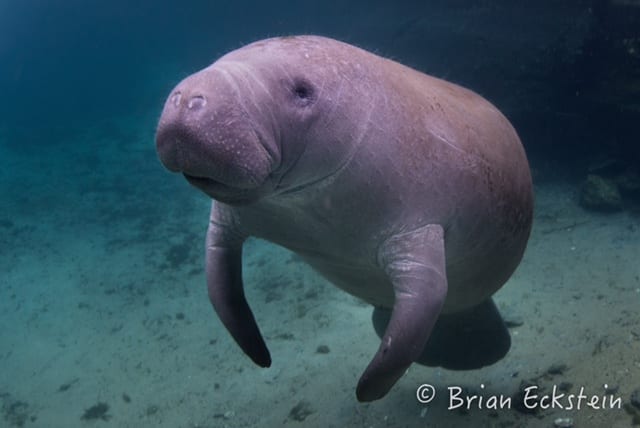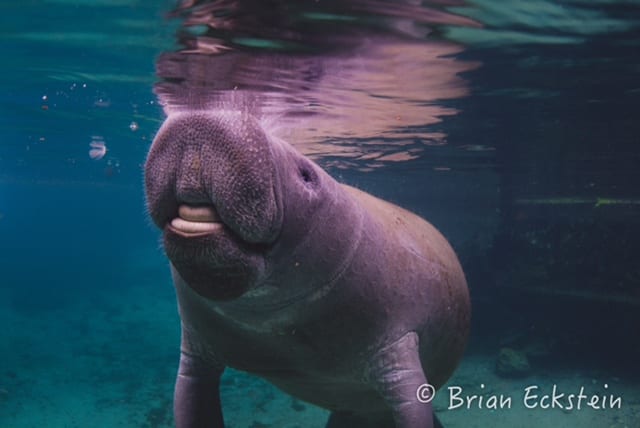by Melissa Johnson, Contributing Writer
As the leaves turn gold and red and Fall’s frosty fingers weave their way across the North, a different scene indicates the imminent arrival of colder weather throughout Florida. Along coastal waterways and up inland rivers, clear blue waters ripple bright green seagrasses as herds of manatees move overhead, making their way to Florida’s freshwater springs.
Manatees’ rotund, wrinkley grey bodies and languid movement through the water give the impression of a blubbery animal, but that is not the case. Much of a mantees’ mass is made up of their stomach and intestines. Although these “sea cows” may spend up to half of their day foraging and munching, their bodies are quite lean and unsuited for the chilly waters that worm their way into Florida estuaries as the weather cools.

Over the course of a day, a manatee may eat up to 10% of its own body weight in seagrasses, algae and water plants. This is perhaps a surprising quantity of food, as the average manatee weighs between 800 – 1,500 pounds. Even with a continuous supply of nutrition, however, manatees have little body fat and a low metabolic rate, which means that their bodies can’t offset the loss of heat when water cools below 68 degrees.
The crystal clear freshwater of Florida’s springs stay around 72 degrees year round. When air temperatures drop low enough that Floridians begin to consider wearing shoes instead of sandals, manatees begin their large congregations inland. During winter, water in the springs is comparatively warm, and the inflow of hundreds of bodies log-jamming the waterways helps keep groups of manatees warm en masse.
Manatees are unique creatures in many more ways than their seasonal migration pattern, which often takes them North instead of South. Their closest living relative is the elephant, a likeness which can be seen particularly in the stubby toenails that dot their front flippers.
Manatees are one of the rare marine creatures that can tolerate saltwater, brackish water, and freshwater. Unlike humans, who are born with only 2 sets of teeth, these marine mammals will replace their teeth throughout their lives.
Manatees breathe oxygen, and can stay submerged for up to 15 minutes before surfacing for air. When they are swimming, manatees breathe more rapidly, and must surface every 3 – 4 minutes. They usually swim at a sluggish pace of around 5 miles per hour, but can swim in short bursts up to 15 miles per hour. In the aquatic world, manatees are still some of the slowest moving animals, and particularly at risk for human-caused injury from collisions with boats and scarring from propellers.

Luckily, manatees are a federally protected species. It is illegal to harass, hunt or kill manatees, which includes touching or feeding them.
Swimming amongst throngs of manatees is an experience unlike any other, and Florida is one of few places in world where congregations of manatees occur in such large numbers. Every winter, Pura Vida Divers leads an expedition of local snorkelers and SCUBA divers to observe this natural phenomenon firsthand.
The trip is open to swimmers of all ages and experience levels, and includes snorkeling sessions, afternoon SCUBA dives, and exploration of some of Florida’s beautiful nature preserves. To learn more about upcoming dates and availability, contact Pura Vida Divers at 561-840-8750 or info.pvd@puravidadivers.com.